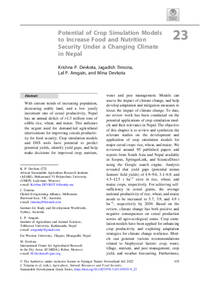Potential of Crop Simulation Models to Increase Food and Nutrition Security Under a Changing Climate in Nepal

Authors:
With current trends of increasing population, decreasing arable land, and a low yearly increment rate of cereal productivity, Nepal has an annual deficit of >1.3 million tons of edible rice, wheat, and maize. This indicates the urgent need for demand-led agricultural interventions for improving cereals productivity for food security. Crop simulation models and DSS tools have potential to predict potential yields, identify yield gaps, and help make decisions for improved crop, nutrient, water and pest management. Models can assess the impact of climate change, and help develop adaptation and mitigation measures to lesses the impact of climate change. To date, no review work has been conducted on the potential applications of crop simulation models and their relevance in Nepal. The objective of this chapter is to review and synthesize the relevant studies on the development and application of crop simulation models for major cereal crops: rice, wheat, and maize. We reviewed around 95 published papers and reports from South Asia and Nepal available in Scopus, SpringerLink, and ScienceDirect using the Google search engine. Analysis revealed that yield gaps (potential minus farmers' field yields) of 4.9–9.0, 3.1–6.9, and 4.5–12.5 t ha−1 exist in rice, wheat, and maize crops, respectively. For achieving self-sufficiency in cereal grains, the average national productivity of rice, wheat, and maize needs to be increased to 5.7, 3.9, and 4.9 t ha−1, respectively by 2030. Based on the review, climate change has both positive and negative consequences on cereal production across all agro-ecological zones. Crop simulation models have been applied for enhancing crop productivity and exploring adaptation strategies for climate change resilience. Models can generate various recommendations related to biophysical factors: crop, water, tillage, nutrient, and pest management, crop yield, and weather forecasting. Furthermore, models have shown the potential to determine the effects of climate change on crop productivity across a range of environments in Nepal. In conclusion, crop simulation models could be useful decision support tools for policy planning and implementation, increasing efficiency in research, prioritizing research and extension interventions for increasing crop yields, and the way forward to achieve food and nutritional security and some of the Sustainable Development Goals (particularly #1, #2 and #13).
